-40%
Japan 1500's-1700's Gold 1 Bu coin, Rare Koshu issue , Matsuki Clan, PCGS VF-35
$ 607.19
- Description
- Size Guide
Description
Japan 1500's-1700's Gold 1 Bu,┬Ā Koshu issue,┬Ā Minted by the Matsuki Clan under the authority of famous samurai Takeda Shingen,┬Ā ┬Ā The picture of Takeda Shingen is shown with the coin pictures. ┬Ā┬Ā┬Ā Takeda Shingen was head of the Takeda clan from 1541 to 1573.Grade circulated.┬Ā┬Ā┬Ā PCGS graded VF-35
Weight 3.71 grams
Catalog reference:┬Ā┬Ā JNDA09-87, Fr-40, KM-94
Rare provincial gold coin from feudal Japan, issued from the Koshu area which was operating gold mines at the time.┬Ā Official government issue 1 bu gold coin.
Kai Province
, the ancestral home of the
Takeda clan
is a very mountainous area which is rich in mineral resources. After
Takeda Shingen
seized power from his father and unified the province, he developed the gold resources which were known to exist in various areas of the province, minting gold coins called "K┼Źsh┼½ kin", which were in great demand due to their purity.
The
Kurokawa mine
is located on the hillside of Mount Keikan (also known as Mount Kurokawa) in the northeastern part of the prefecture, at an elevation of 1350 to 1400 meters. Gold in the form of gold dust was known to have been extracted from the area since at least the early
Kamakura period
, however, exploitation began in earnest by Takeda Shingen and the locations of more than thirty mineheads and a smelter ruins have been found in this area, along with a mining town. Production is estimated to have reached its peak during the tenure of his son,
Takeda Katsuyori
. After the fall of the Takeda clan, Kai Province came under the control of
Tokugawa Ieyasu
, and the mines continued to operate into the
Edo period
under the control of the
Tokugawa shogunate
.












